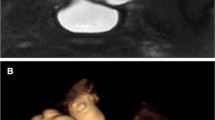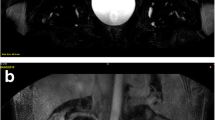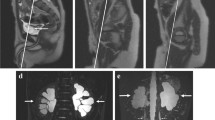Abstract
In this article we introduce the topic of MR urography in children, focusing on the details required to obtain consistently high-quality scans. Much of the information presented is based on our experience during the last 7 years. We have performed almost 1,000 MR urograms in children, and the technique has evolved considerably during this time. We have learned through trial and error and have improved our protocols to the point that our approach is now standardized and reliably generates high-quality studies. From this standardized protocol, further refinements in technique can be readily implemented. It is important to remember that this clinical application is in its infancy and will improve significantly with further technical development. This paper provides an overview of the practical issues associated with obtaining high-quality scans as well as an introduction into the interpretation of MR urograms.


















Similar content being viewed by others
References
Grattan-Smith JD, Jones RA (2006) MR urography in children. Pediatr Radiol 36:1119–1132
Grattan-Smith JD, Perez-Bayfield MR, Jones RA et al (2003) MR imaging of kidneys: functional evaluation using F-15 perfusion imaging. Pediatr Radiol 33:293–304
Jones RA, Easley K, Little SB et al (2005) Dynamic contrast-enhanced MR urography in the evaluation of pediatric hydronephrosis: part 1 functional assessment. AJR 185:1598–1607
Kirsch AJ, McMann LP, Jones RA et al (2006) Magnetic resonance urography for evaluating outcomes after pediatric pyeloplasty. J Urol 176:1755–1761
McDaniel BB, Jones RA, Scherz H et al (2005) Dynamic contrast-enhanced MR urography in the evaluation of pediatric hydronephrosis: Part 2, anatomic and functional assessment of uteropelvic junction obstruction. AJR 185:1608–1614
Perez-Brayfield MR, Kirsch AJ, Jones RA et al (2004) A prospective study comparing ultrasound, nuclear scintigraphy and dynamic contrast-enhanced magnetic resonance imaging in the evaluation of hydronephrosis. J Urol 170:1330–1334
English PJ, Testa HJ, Lawson RS et al (1987) Modified method of diuresis renography for the assessment of equivocal pelviureteric junction obstruction. Br J Urol 59:10–14
Brown SC, Upsdell SM, O’Reilly PH (1992) The importance of renal function in the interpretation of diuresis renography. Br J Urol 69:121–125
Rohrschneider WK, Becker K, Hoffend J et al (2000) Combined static-dynamic MR urography for the simultaneous evaluation of morphology and function in urinary tract obstruction. II. Findings in experimentally induced ureteric stenosis. Pediatr Radiol 30:523–532
Rohrschneider WK, Hoffend J, Becker K et al (2000) Combined static-dynamic MR urography for the simultaneous evaluation of morphology and function in urinary tract obstruction. I. Evaluation of the normal status in an animal model. Pediatr Radiol 30:511–522
Nolte-Ernsting CC, Adam GB, Gunther RW (2001) MR urography: examination techniques and clinical applications. Eur Radiol 11:355–372
Jones RA, Perez-Brayfield MR, Kirsch AJ et al (2004) Renal transit time with MR urography in children. Radiology 233:41–50
Hackstein N, Heckrodt J, Rau WS (2003) Measurement of single-kidney glomerular filtration rate using a contrast-enhanced dynamic gradient-echo sequence and the Rutland-Patlak plot technique. J Magn Reson Imaging 18:714–725
Hackstein N, Kooijman H, Tomaselli S et al (2005) Glomerular filtration rate measured using the Patlak plot technique and contrast-enhanced dynamic MRI with different amounts of gadolinium-DTPA. J Magn Reson Imaging 22:406–414
Wahl EF, Lahdes-Vasama TT, Churchill BM (2003) Estimation of glomerular filtration rate and bladder capacity: the effect of maturation, ageing, gender and size. BJU Int 91:255–262
Sharkey I, Boddy AV, Wallace H et al (2001) Body surface area estimation in children using weight alone: application in paediatric oncology. Br J Cancer 85:23–28
Tsushima Y, Blomley MJ, Okabe K et al (2001) Determination of glomerular filtration rate per unit renal volume using computerized tomography: correlation with conventional measures of total and divided renal function. J Urol 165:382–385
Brenner BM, Mackenzie HS (1997) Nephron mass as a risk factor for progression of renal disease. Kidney Int Suppl 63:S124–S127
Brenner BM, Lawler EV, Mackenzie HS (1996) The hyperfiltration theory: a paradigm shift in nephrology. Kidney Int 49:1774–1777
Chevalier RL, Roth JA (2007) Renal function in the fetus, neonate, and child. In: Wein AJ, Kavoussi LR, Novick AC et al (eds) Campbell-Walsh urology, 9th edn. Saunders, Philadelphia, ch 107
Krier JD, Ritman EL, Bajzer Z et al (2001) Noninvasive measurement of concurrent single-kidney perfusion, glomerular filtration, and tubular function. Am J Physiol Renal Physiol 281:F630–F638
Daghini E, Primak AN, Chade AR et al (2007) Assessment of renal hemodynamics and function in pigs with 64-section multidetector CT: comparison with electron-beam CT. Radiology 243:405–412
Author information
Authors and Affiliations
Corresponding author
Additional information
Dr. Grattan-Smith receives grant support from Siemens. Content of this article will describe use of a medical device or pharmaceutical that is “off-label,” i.e. a use not described on the product’s label.
Rights and permissions
About this article
Cite this article
Grattan-Smith, J.D., Little, S.B. & Jones, R.A. MR urography in children: how we do it. Pediatr Radiol 38 (Suppl 1), 3–17 (2008). https://doi.org/10.1007/s00247-007-0618-7
Received:
Accepted:
Published:
Issue Date:
DOI: https://doi.org/10.1007/s00247-007-0618-7




